 Pin
Pin Above shows the making of an early ‘talkie’. Cameramen are enclosed in a booth, for noise from non-insulated cameras ruined the soundtrack.
Experiments to add sound to films had started as early as 1900, when the silent cinema was in its infancy. By 1913, the Frenchman, Eugene Lauste, working in London, had made a sound-on-film projector and a reproducing apparatus. The outbreak of World War One in 1914, however, halted his work.
Those who followed him could not solve the key problem of how to get good sound. Their efforts were agony on the ears. In the mid-1920s, the firm of Warner Brothers in Hollywood were in a bad way. Only their celebrated dog star, Rin Tin Tin, was bringing in money, and it was feared his popularity might eventually fade. Ruin stared them in the face, but perhaps sound might save them…
The brothers made a one-reel film using their ‘Vitaphone’ process, which was a sound-on-disc system synchronised with a moving picture. The popular entertainer, Al Jolson, was observed — and heard — singing Southern songs on a plantation. He also sang the hit song, April Showers.
None of Warner Brothers’ rivals was alarmed by the film, for they were convinced the new system was only fit for fairgrounds.
Then a young executive of Warner Brothers, Darryl F. Zannuck, talked his bosses into producing a full-length feature film with sound, not just short efforts. The subject chosen was The Jazz Singer, which was already a hit on stage in New York. Al Jolson agreed to make what was to be a mainly silent picture plus a few songs, with snatches of background music. Al, however, began dropping in more and more dialogue: “Wait a minute. You ain’t heard nothin’ yet. Wait a minute I tell yer… You wanna hear ‘Toot Toot Tootsie’… .’’ and so on.
Warner Brothers saw the light and ordered more dialogue. The result was a sensation. At the Warner Theatre in New York, there were incredible scenes at the premiere, with people sobbing and howling for joy. Warner’s rivals had come to scoff, but now raced to send telegrams to their studios ordering sound equipment to be bought — fast.
 Pin
Pin Above, a modern ‘talkie’ is made. Cameras now are ‘blimped’. That is sound is excluded by use of sound-proof covers. The microphone is moved around on a boom and a man listening in through ear-phones operates a sound mixer. This shows filming of a studio shot.
Some tried to pretend that sound movies were just a fad, but the colossal success of The Jazz Singer proved them wrong. Other sound films were soon being made and a new system, called Movietone, improved quality because the sound was recorded along the edge of the film by a method of photography. Soon all talkies were using it.
The only losers were silent stars who were found to have unsuitable voices — ones that were thought to be rather unpleasing.
Many stars made the changeover successfully, however, including Laurel and Hardy, the great comic stars.
Now the golden age of movies began, an age which was to last until the 1950s when television began to keep many people at home. For much of the golden age, folk all over the world were going to the cinema at least once a week and many millions were going twice. Colour, first used as early as 1906, became increasingly common from around 1935.
Westerns, musicals, horror films, gangster movies, comedies and love stories poured off the Hollywood assembly lines. The flood included ‘‘B Pictures’’, for until the 1950s, filmgoers expected — and usually got — two films every time they went to the cinema. The “B pictures” were generally slightly shorter and had lesser stars.
Star System
The star system probably reached its height during the 1930s and 1940s and, thanks to television, today’s young people know many of the stars of those years: for example, Clark Gable, Spencer Tracy, Bette Davis, Gary Cooper, Greta Garbo.
There were many fine directors, one of the best being an Englishman who went to Hollywood — Alfred Hitchcock of thriller fame.
A really remarkable film of the golden age of the talkies was Citizen Kane, the very first film directed by Orson Welles, who came to Hollywood in his early twenties from the theatre and radio and made a revolutionary masterpiece.
It was revolutionary because of his marvellous use of sound, music, camera angles, off-screen voices, including an off-screen narrator for some of the time, brilliant lighting and brilliant flash-backs. He even had time to write and produce it and to act the leading role from young manhood to old age. It remains an amazing achievement.
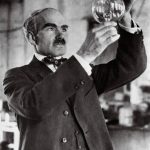 Pin
Pin 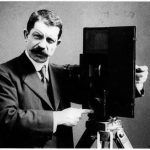 Pin
Pin Two important men of the early cinema were Lee de Forest and Leon Gaumont.
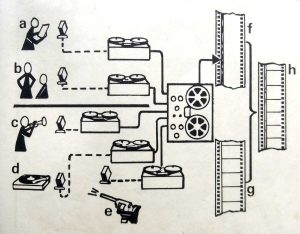 Pin
Pin This above diagram shows the mixture of commentary track (a) with live dialogue track (b). It also shows the mixture of recorded music track (c) with re-recorded disc track (d) and special sound effects track (e). All five mixed together form a master magnetic track. This is then transcribed on to an optical tape (f) which, when amalgamated with a picture tape (g) makes the complete sound and vision track (h).
Foreign Films
In the 1950s, Hollywood got scared. Attendances were falling all around the world because of television and, though new processes like Cinemascope and Cinerama (wide-screen presentations) resulted in occasional huge successes that made fortunes, many more films lost fortunes. Other film industries suffered, too, including Britain’s, France’s and Italy’s. Thousands of cinemas closed and experiments, like films in 3-D, which needed special glasses to see, did not help much. Even the ever-popular Westerns seemed to be losing their touch, though John Wayne plus a good director could usually fill a cinema.
The word went out: fewer but better movies. They have not always been better, but the cinema as mass entertainment flourishes again in a more modest way. It is helped by the fortunes made by hits like Jaws 1 and 2, Star Wars etc., which make money that can be ploughed back into new ventures. Technically speaking, films are very well made and there are still many good actors though superstars are less frequently created.
The nearest to the old days is, perhaps, ‘India’s film industry, which appeals to an enormous local market, though maybe the finest Far Eastern films have come from Japan. Britain’s film industry has been crippled for too long by lack of money, yet her technicians and actors are among the best in the world. However, at the time of writing, British money is being used to make a number of Hollywood films, so the omens seem more favourable, especially as more truly British films are at last being produced again.
Meanwhile, millions around the world still go to the movies, and it is hard to believe that there will come a time when they will cease to do so, even if most homes have their own cinema.
Perhaps Al Jolson .was right: “You ain’t heard (or seen) nothin’ yet.”
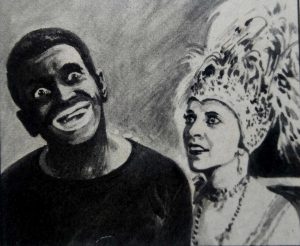 Pin
Pin From the Warner Bros’ “Jazz Singer” (above) to the 20th Century Fox “The Empire Strikes Back” (below) — great strides have been made in the technique of adding multiple sound to film.
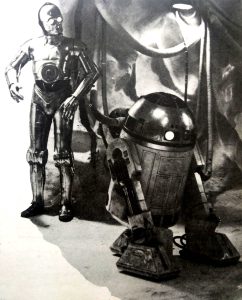 Pin
Pin The introduction of sound in films, also known as the "talkies", had a tremendous impact on the movie industry and revolutionized storytelling onscreen in several ways:
-
Enhanced Realism
Sound brought a new level of realism to films, as audiences could now hear the characters’ voices and the sounds of their surroundings. This made the stories more immersive and allowed filmmakers to create a more believable and engaging cinematic experience.
-
Dialogue-driven narratives
CopiedDialogue-driven narrativesWith the addition of sound, dialogue became a vital component of storytelling. Films could rely less on visual cues and more on conversations between characters to advance the plot. This led to the development of dialogue-driven narratives that focused on character interactions, verbal exchanges, and witty banter.
With the addition of sound, dialogue became a vital component of storytelling. Films could rely less on visual cues and more on conversations between characters to advance the plot. This led to the development of dialogue-driven narratives that focused on character interactions, verbal exchanges, and witty banter.
-
Musical Scores
CopiedMusical ScoresSound also introduced the use of musical scores in films. Composers could now create original music specifically tailored to the story, heightening emotions, and creating a more dramatic impact. Musical scores became an integral part of storytelling, enhancing the mood, pacing, and overall narrative experience.
Sound also introduced the use of musical scores in films. Composers could now create original music specifically tailored to the story, heightening emotions, and creating a more dramatic impact. Musical scores became an integral part of storytelling, enhancing the mood, pacing, and overall narrative experience.
-
Expansion of Genres
CopiedExpansion of GenresThe introduction of sound paved the way for the growth of various film genres, such as musicals and talkie adaptations of stage plays and novels. Musicals allowed filmmakers to combine music, dance, and storytelling, creating a unique and popular genre. Additionally, famous literary works could now be faithfully adapted with dialogue and sound, broadening the range of stories that could be told onscreen.
The introduction of sound paved the way for the growth of various film genres, such as musicals and talkie adaptations of stage plays and novels. Musicals allowed filmmakers to combine music, dance, and storytelling, creating a unique and popular genre. Additionally, famous literary works could now be faithfully adapted with dialogue and sound, broadening the range of stories that could be told onscreen.
-
Technical Innovations
CopiedTechnical InnovationsThe transition to sound required significant technological advancements in filmmaking. Sound recording methods, microphones, and playback systems had to be developed, laying the foundation for future innovations in sound technology. Furthermore, the need for soundproof booths and better acoustic techniques led to advancements in studio design and construction.
The transition to sound required significant technological advancements in filmmaking. Sound recording methods, microphones, and playback systems had to be developed, laying the foundation for future innovations in sound technology. Furthermore, the need for soundproof booths and better acoustic techniques led to advancements in studio design and construction.
The introduction of sound in films not only impacted the technical aspects of movie-making but also changed the way stories were presented and experienced onscreen. It opened up new creative possibilities for filmmakers and turned films into a richer, more immersive art form.
The first major film that successfully incorporated synchronized sound was “The Jazz Singer,” released in 1927. Directed by Alan Crosland, this seminal film introduced synchronized dialogue sequences, as well as synchronized musical numbers. While it wasn’t entirely a “talkie” (a film with continuous synchronized sound throughout), it marked a significant turning point in the cinematic landscape.
“The Jazz Singer” starred Al Jolson, a well-known entertainer of the time, as a young Jewish man named Jakie Rabinowitz, who defies his family’s traditions to pursue a career in showbiz, particularly in jazz singing. Rather than using intertitles, which were the standard method of incorporating dialogue in silent films, “The Jazz Singer” employed synchronized sound techniques.
The film utilized the Vitaphone sound-on-disc system, developed by Warner Bros., which involved recording sound onto vinyl records that were played alongside the film projection. Only about 20 minutes of the entire film included synchronized sound sequences, including Jolson’s famous line, “You ain’t heard nothin’ yet!” This dialogue and the musical performances used synchronized sound, making the emotional connection and storytelling more vibrant and immersive for the audience.
“The Jazz Singer” revolutionized the cinema industry in several important ways. First, it demonstrated the efficacy of synchronized sound and proved that audiences were ready for sound films. It shattered the preconceptions that films needed to be silent and opened up a new era of sound cinema. The success of this film prompted other studios to swiftly adopt synchronized sound technologies, leading to the rapid decline of silent cinema.
Second, as a cultural milestone, “The Jazz Singer” portrayed themes of immigration, cultural identity, and generational conflicts. It allowed audiences to witness a realistic representation of diverse characters and stories on the screen. Through the integration of synchronized sound, the film further emphasized emotions, the power of dialogue, and the raw energy of music.
The impact of “The Jazz Singer” on filmmaking was profound. It led to a rapid shift from silent films to sound films, also known as the “talkie revolution.” Studios worldwide began investing in sound equipment, and filmmakers had to adapt their storytelling techniques to incorporate sound effectively. Many silent film stars struggled to make the transition since the new technology required different acting skills, but for the industry as a whole, sound cinema became the new norm.
“The Jazz Singer” changed the landscape of cinema by proving the commercial viability of synchronized sound and initiating a transformative period of innovation and experimentation that forever altered how films were made and experienced.
The transition from silent films to talkies required several technological advancements to make the inclusion of synchronized sound possible. Some of the crucial advancements include:
- 1. Sound-on-Disc Technology: Initially, sound was recorded separately on phonograph discs, and projectionists had to manually synchronize the audio with the film, a process known as “sound-on-disc.” This method required improved recording and playback technologies to ensure accurate synchronization.
- 2. Sound-on-Film Technology: The introduction of optical sound-on-film allowed the audio to be recorded directly onto the film strip. This technology used a separate soundtrack, consisting of a narrow strip of photographic film with a series of recorded sound waves that could be played back in sync with the film. This eliminated the need for synchronization between a separate sound source and the film projection.
- 3. Microphone and Sound Recording Equipment: The development of sensitive microphones and sound recording equipment capable of capturing high-quality sound was essential. Initially, large and cumbersome microphones were used, but advancements led to more compact and efficient sound recording devices.
- 4. Amplification and Speaker Systems: The incorporation of amplifiers and advanced speaker systems was crucial to reproduce the recorded sounds in a clear and audible manner. The sound needed to be broadcasted throughout the cinema hall to ensure an immersive experience for the audience.
- 5. Acoustic Treatments in Theaters: Theaters had to undergo renovations to improve acoustics and reduce background noise. This included installing sound-absorbing materials on walls, floors, and ceilings, as well as redesigning auditorium layouts to optimize sound distribution.
The technological advancements in recording, playback, synchronization, and audio reproduction were necessary to facilitate the transition from silent films to talkies and create a seamless integration of sound and visuals in the film industry.
The pioneers or key figures responsible for successfully incorporating sound into films were:
- 1. Thomas Edison: While not directly responsible for incorporating sound, Thomas Edison invented the Phonograph in 1877, which demonstrated the concept of recording and playing back sounds. This invention laid the groundwork for the future development of synchronized sound in films.
- 2. Lee de Forest: In 1923, Lee de Forest invented the Audion, a vacuum tube that amplified weak electrical signals. This invention allowed for better sound amplification and transmission, creating a crucial component for the development of synchronized sound in films.
- 3. Warner Bros. Studio: Warner Bros. played a significant role in the successful incorporation of sound into films. In 1926, Warner Bros. released “Don Juan,” which featured a synchronized musical score. However, it was their release of “The Jazz Singer” in 1927 that revolutionized the industry. “The Jazz Singer” was the first feature-length film to include synchronized dialogue sequences. Its success marked a turning point in the film industry’s transition from silent to sound films.
The contributions of these pioneers and key figures shaped the future of the film industry in several ways:
- 1. Transition to Sound Films: Prior to the successful incorporation of sound, films were silent and accompanied by live music or text-based intertitles for dialogue. The introduction of synchronized sound revolutionized the industry, leading to the rapid transition from silent to sound films.
- 2. Enhanced Storytelling: The addition of sound allowed filmmakers to tell stories with dialogue, music, and sound effects. This opened up new possibilities for character development, emotional impact, and audience engagement. Films could now convey a range of information and create a more immersive experience.
- 3. Growth of the Film Industry: The transition to sound films created a surge in demand for new equipment like microphones, amplifiers, and soundproof studios. This led to the establishment and growth of industries related to sound recording and distribution, creating new job opportunities and contributing to the overall growth of the film industry.
- 4. Standardization of Sound Systems: The pioneers’ contributions led to the establishment of sound system standards, such as the Western Electric’s Vitaphone system and RCA Photophone, which allowed for the consistent reproduction of synchronized dialogue and music in theaters. This standardization facilitated the seamless integration of sound into films across different locations, ensuring a consistent experience for audiences.
The pioneers and key figures responsible for incorporating sound into films, such as Thomas Edison, Lee de Forest, and Warner Bros. Studio, played a crucial role in shaping the future of the film industry. Through their inventions, innovations, and successful productions, they paved the way for the transition to sound films, enhanced storytelling capabilities, and the growth of the film industry as a whole.
Frequently Asked Questions: The introduction of sound in films
Films began to speak in the late 1920s with the introduction of “talkies.” Prior to that, films were silent and relied on live music, sound effects, and occasionally intertitles to convey the storyline, dialogues, and emotions.
The transition from silent films to talkies was primarily driven by technological advancements in the film industry. The development of synchronized sound systems, such as the Vitaphone and Movietone, allowed for the incorporation of recorded sound into films. This breakthrough technology revolutionized the movie-going experience and attracted larger audiences.
The Jazz Singer, released in 1927, is widely regarded as the first feature-length motion picture with synchronized sound. Starring Al Jolson, this film included several synchronized musical numbers, dialogues, and sound effects. Although most of the movie is silent, its success paved the way for future talkies.
The introduction of sound had a profound impact on the film industry. It opened up new possibilities for storytelling, as filmmakers no longer had to rely solely on visuals to convey the narrative. Sound, including dialogues, music, and sound effects, added a rich layer of realism and immersion to the films, captivating audiences in a whole new way. This transition also led to an increased demand for actors with good voices and the development of sound recording technologies and techniques.
While the popularity of silent films declined with the advent of synchronized sound, they were not completely replaced. Many filmmakers and audiences still appreciated the unique artistic and storytelling qualities of silent films, even after the introduction of sound. Silent films continued to be made, particularly in countries where sound technologies were not yet readily available or affordable. However, the vast majority of film productions transitioned to the talkies format due to its commercial success and broader audience appeal.
Yes, the introduction of sound presented several challenges for the film industry. One of the major challenges was the need for specialized equipment in theaters to accommodate sound films. Many theaters had to invest significantly in retrofitting their establishments with sound systems, causing financial strain for some smaller cinemas. Additionally, filmmakers had to adjust their techniques to effectively incorporate sound, including finding the right balance between dialogue, sound effects, and music. This required new skills and expertise, leading to a learning curve for directors, actors, and technicians.
The transition to sound significantly affected actors, as it introduced the necessity of verbal performance. Many successful silent film actors struggled to adapt to the talkies because they had built their careers on visual expressions and exaggerated gestures. Those with strong and appealing voices gained prominence, while many silent film superstars who had thick accents or unappealing voices faced difficulties in the new era of sound. This shift also resulted in a change from pantomime-style acting to more naturalistic performances, as actors had to learn to synchronize their movements and speech.
The introduction of sound impacted film genres by expanding the range of storytelling possibilities. Musical films, in particular, gained immense popularity, as synchronized sound allowed for the incorporation of songs and dance numbers. Genres like comedies also benefited from sound, as audiences could now hear the comedic timing, witty dialogues, and funny sound effects. Additionally, sound allowed for more realistic and intense portrayals of drama and action, enhancing the emotional impact of these genres.
While many silent film actors faced difficulties in transitioning to talkies, there were several notable performers who made successful leaps. Some examples include Charlie Chaplin, whose first “talkie” film, The Great Dictator, released in 1940, showcased his vocal talents. Buster Keaton, Greta Garbo, and Joan Crawford are among others who managed to maintain their popularity in the sound era. However, overall, the shift to sound led to a reshuffling of the movie star hierarchy, with new actors emerging and old ones fading.
The advent of sound had a tremendous impact on global cinema. Initially, sound films faced language barriers, as different countries spoke different languages. To ensure wider international distribution, studios had to invest in dubbing or creating multiple language versions of films. This led to further advances in dubbing and subtitling technologies, which facilitated the global spread of films. Moreover, the rise of sound films intensified Hollywood’s dominance in the international film market, as the English language became a significant advantage in reaching a broad audience. Nevertheless, various countries also developed their own successful film industries, creating films in their native languages that resonated with local audiences.




























